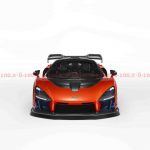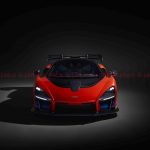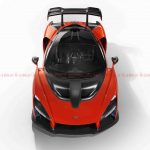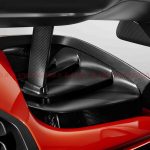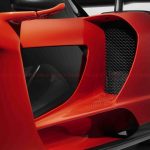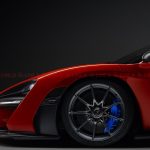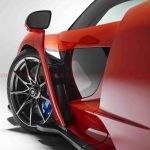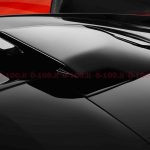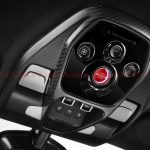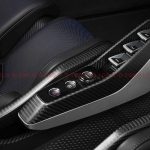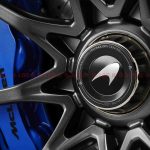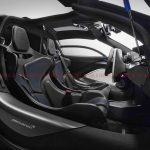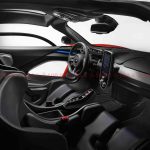NOVITA’: McLaren Senna[:en]McLaren Senna aims to be the fastest fully road-legal track car in the world
NON E’ IBRIDA (DEO GRATIAS!). RISPETTO ALLE FORME SINUOSE DELLA P1, IL DESIGN DELLA MCLAREN SENNA E’ FUNZIONE PURA. QUINDI E’ BRUTTINA MA CON UN CONTENUTO TECNICO STRAORDINARIO. MENTRE LA P1 ERA DEFINITA COME “LA MIGLIORE AUTO DA GUIDARE SU STRADA E PISTA”, LA SENNA INTENDE ESSERE “LA MIGLIORE AUTO DA PISTA OMOLOGATA STRADALE”. COME, DEL RESTO ERA LA FAVOLOSA F1 E COME FU LA M6GT DEL ’69, PRIMA MCLAREN STRADALE DELLA STORIA. PRODUZIONE (500 ESEMPLARI) GIA’ TUTTA VENDUTA.
La nuova McLaren Senna (nuovo modello della gamma Ultimate Series che precede la futura BP23 a tre posti), la traduzione in termini “da listino” del progetto P15, erede della P1, della F1 e della M6GT del ’69, è finalmente realtà.
Per sottolineare la sua natura di veicolo da pista (ma rigorosamente omologato stradale) è stata denominata come il grande pilota brasiliano (Ayrton vinse, a bordo di vetture McLaren, i titoli piloti di F1 nel 1988, 1990 e 1991).
DESIGN
Il fascino della McLaren Senna non sta assolutamente nel design, studiato per essere funzione pura e senza concessioni alla forma e a superfici sinuose, morbide, slanciate e proporzionate. Non sarebbe difficile confonderla con una macchina da corsa per il Mondiale Endurance WEC. Per “togliere peso”, sia dal punto di vista visivo che funzionale, i designer McLaren hanno quindi sacrificato le forme per cercare di vestire la sua meccanica estrema. Con il risultato che la carrozzeria della Senna è un tripudio di prese d’aria, lame, uscite di flusso e superfici alari (anteriormente e posteriormente cambiano l’incidenza in modo attivo a seconda della situazione dinamica: accelerazione, curva o frenata).
TELAIO
La McLaren Senna si basa sul telaio monoscocca in carbonio, che in questo caso ha raggiunto lo status di Monocage III. E’ un ulteriore sviluppo della scocca della 720S ed è ancora più rigida e leggera.
Le sospensioni, a doppi triangoli sovrapposti, dispongono di un sistema idraulico che sostituisce le normali barre antirollio. Gli ammotrizzatori idraulici a controllo elettronico sono integrati con sistema RaceActive Chassis Control II (RCC II) e K-damper che controllano durezza e altezza da terra.
L’impianto freni, con dischi in carboceramica, è abbinato a ruote ultraleggere con dado di fissaggio centrale e pneumatici sviluppati appositamente.
MOTORE
Il propulsore è il nuovo M840TR, il classico V8 biturbo (con turbocompressori Twin-scroll e valvole waste-gate a controllo elettronico), che in questo caso è stato modificato passando da 3,8 a 4 litri. Questo propulsore, con carter secco e albero motore piatto, fornisce 800 cavalli e 800 Nm di coppia massima. E’ accoppiato a un cambio a doppia frizione con sette rapporti. E, naturalmente, trazione posteriore.
Il pilota dispone del sistema Active Dynamics Panel, che permette di scegliere tra tre sistemi di gestione del veicolo: Comfort, Sport e Track (agiscono su motore, trasmissione e ammortizzatori).
PRODUZIONE
McLaren annuncia anche il prezzo (750.000 Sterline, oltre 850.000 €) della Senna. Ma la produzione – 500 esemplari – è già stata tutta assegnata.
THERE ARE STRONG ECHOES IN THE NEW MCLAREN SENNA OF THE INCREDIBLY FOCUSED PHILOSOPHY BEHIND THE MCLAREN P1™; WHERE THE LATTER WAS DESIGNED TO BE THE BEST DRIVER’S CAR ON ROAD AND TRACK, THE AMBITION FOR THE MCLAREN SENNA IS FOR IT TO BE THE BEST ROAD-LEGAL TRACK CAR, SETTING A NEW BENCHMARK FOR CIRCUIT EXCELLENCE WITH TRACK PROWESS ABSOLUTELY TAKING PRECEDENCE.
The McLaren Senna has been created to be the ultimate McLaren track-concentrated car for the road.
The technical recipe is classic McLaren Automotive supercar: ultra-lightweight construction, with carbon fibre chassis and body panels, mid-mounted, twin-turbocharged V8 McLaren engine, Rear wheel drive, sophisticated race-derived suspension that delivers an unparalleled blend of control and dynamic balance. Electro-hydraulic steering that rewards accurate inputs and gives the purest feedback. And two seats – but with absolute focus on the importance of the one that the driver occupies.
CHASSIS
The carbon fibre Monocage III chassis is a further development of the structure that underpins the McLaren 720S. Every body panel is made from carbon fibre, in line with a relentless focus on the weight of every individual component that has resulted in the McLaren Senna being the lightest road-legal McLaren since the
iconic F1 road car, at just 1,198kg.
With maximum power of 800PS (789bhp), the McLaren Senna enjoys a power-to-weight ratio of 668PS per tonne.
RCC II is a double-wishbone suspension system that additionally features hydraulically interconnected dampers and a hydraulic replacement for conventional mechanical anti-roll bars. It also further develops the variable stiffness and ride height technology first seen in the pioneering hydraulic system in the McLaren P1™.
The adaptive dampers are interconnected hydraulically, both left to right and front to back, with two valves per damper to independently adjust for compression and rebound. The stiffness of the McLaren Senna is separately controlled using a kinetic roll system, or K-damper. The continuously variable RCC II system
advances the control strategy introduced on the McLaren 720S and also adds a Race mode, which introduces a lower ride height, lower centre of gravity and significantly stiffer suspension.
Dynamic parameters are adjusted by the driver through the Active Dynamics Panel located on the centre console to select Comfort, Sport or Track modes or via a switch in a roof-mounted panel to access Race mode. The braking system of the McLaren Senna is the most advanced ever fitted to a McLaren road car, using carbon ceramic discs and motorsport technologies to deliver extreme performance. Tyre choice is equally focused, with bespoke Pirelli P Zero™ Trofeo R tyres developed in conjunction with McLaren technical partner, Pirelli. Designed for race tracks but approved for road use, they enable a McLaren Senna to be driven to a circuit. Only one style of wheel is available: an ultra-lightweight alloy wheel with a race-inspired centre lock system.
DESIGN
With downforce and aerodynamic balance the guiding principles, this car is the purest expression yet of the ‘form follows function’ design philosophy embraced by McLaren.
Viewed from above, the body is nature’s most efficient shape – a teardrop – with body components ‘clipped’ onto the cabin to deliver optimal aerodynamic performance. McLaren’s designers went to extremes by cutting open the ‘shrink-wrapped’ body to reduce weight visually and functionally. Every element of the body design, from the front splitter to the double diffuser at the rear, has been developed to optimise downforce and aerodynamic balance, whether under braking, adjusting the throttle mid corner, or applying power on corner exit. There is also an opportunity for added visual drama, with the front aero blades available finished in one of five ‘By McLaren’ theme specifications that include Azura Blue and McLaren Orange. The same linked accent colour can also feature on the brake calipers, visible door gas struts and seat trims.
Cooling requirements played an equally crucial role: the rear clamshell, for example, was born from the twin demands of aerodynamic and cooling performance, with prominent ‘gurney’ flaps ahead of a succession of stepped louvres directing air away from the rear deck and down the sides of the body. The resulting area of low pressure draws hot air out from the high-temperature radiators and engine bay, with the louvres ensuring that the airflow does not impact the efficiency of the rear wing. The ‘slash cut’ finishers of the unique Inconel and titanium exhaust exit through the lowest rear deck (measured at the trailing edge) of any McLaren road car, the angle of the pipes directing exhaust gas away from the rear wing. Equally unmissable is a huge, doubleelement carbon fibre rear wing that at its highest point sits 1,219mm from the road when the car is stationary. Hydraulically actuated and with a planform surface area of more than 6,500cm2, the wing constantly adjusts to optimise the levels of downforce and aerodynamic balance and functions as an airbrake under heavy braking.
COCKPIT
The doors, which are constructed of carbon fibre, feature two-piece glass side windows with a fixed top part and a smaller opening section below. Both the door upper (effectively part of the roof) and the lower half of the door side can be specified with glass as a replacement for the carbon fibre panels that are standard-fit.
To accommodate the door design, the release mechanisms and window switches are housed alongside the engine start button in a carbon fibre console above the driver’s head. Dependent on customer preference, Alcantara® or leather covers the seats, facia and side airbags, but the absence of any other interior trim both saves weight and reveals the construction of the doors.
Driver controls have been deliberately kept to a minimum to reduce ‘cockpit clutter’ and the three-spoke steering wheel is free of buttons and switches, creating a pure focus on sensory feedback. All the information the driver needs comes from the high-definition McLaren Folding Driver Display and central infotainment screen.
ENGINE AND TRANSMISSION
Codenamed M840TR, the 4.0-litre twin-turbocharged V8 engine produces 800PS (789bhp) and torque of 800Nm (590 lb ft). The engine’s dry sump lubrication and flat-plane crankshaft are technologies with their roots in motorsport. Lightweight internal components reduce mass in the powertrain and combine with ultralow inertia, twin-scroll turbochargers and electronically controlled wastegates to deliver lightning-quick throttle
responsiveness.
From the outset of the programme, McLaren engineers determined that the full mechanical symphony of the
engine – from intake to combustion to exhaust – had to be central to the sensory experience. Those fortunate enough to drive the McLaren Senna will feel the cockpit come alive with the sound of air rushing into the roofmounted ‘snorkel’ intake and mixing in the carbon fibre plenum, producing precisely tailored high-frequency sounds that deliver a vivid experience. At the same time, low-frequency sounds from the engine are transferred into the cockpit through unique engine mounts, exciting the double-walled rear structure of the carbon fibre Monocage and amplifying every change in engine revs, making it seem almost as if the V8 is sitting alongside the driver.
A dual-clutch, seamless-shift, seven-speed gearbox delivers power to the rear wheels. A fully automatic mode is the default, with the driver able to choose full manual control of gear shifts via paddles mounted on a rocker behind the steering wheel. The elongated carbon fibre paddles are optimised to be used both with or without racing gloves, and create a deep sense of mechanical connection with the McLaren Senna.
The character of the 4.0-litre twin-turbo McLaren V8 and the transmission can be tailored using the Active Dynamics Panel, with the driver having a choice of Comfort, Sport or Track powertrain modes. Whatever the mode, performance is suitably savage. Throttle response is immediate and neck-snapping, pinning the driver back into their seat.
PRICE AND PRODUCTION
The third model introduced under the McLaren Track22 business plan, the McLaren Senna will be hand-assembled in England at the McLaren Production Centre. Production will be limited to 500 vehicles, each costing from £750,000 including taxes (UK price) and all already allocated.







